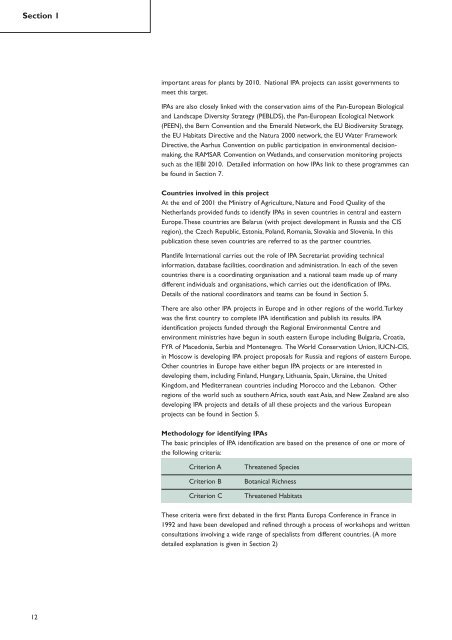important plant areas in central and eastern europe - Plantlife
important plant areas in central and eastern europe - Plantlife
important plant areas in central and eastern europe - Plantlife
You also want an ePaper? Increase the reach of your titles
YUMPU automatically turns print PDFs into web optimized ePapers that Google loves.
Section 1<br />
<strong>important</strong> <strong>areas</strong> for <strong>plant</strong>s by 2010. National IPA projects can assist governments to<br />
meet this target.<br />
IPAs are also closely l<strong>in</strong>ked with the conservation aims of the Pan-European Biological<br />
<strong>and</strong> L<strong>and</strong>scape Diversity Strategy (PEBLDS), the Pan-European Ecological Network<br />
(PEEN), the Bern Convention <strong>and</strong> the Emerald Network, the EU Biodiversity Strategy,<br />
the EU Habitats Directive <strong>and</strong> the Natura 2000 network, the EU Water Framework<br />
Directive, the Aarhus Convention on public participation <strong>in</strong> environmental decisionmak<strong>in</strong>g,<br />
the RAMSAR Convention on Wetl<strong>and</strong>s, <strong>and</strong> conservation monitor<strong>in</strong>g projects<br />
such as the IEBI 2010. Detailed <strong>in</strong>formation on how IPAs l<strong>in</strong>k to these programmes can<br />
be found <strong>in</strong> Section 7.<br />
Countries <strong>in</strong>volved <strong>in</strong> this project<br />
At the end of 2001 the M<strong>in</strong>istry of Agriculture, Nature <strong>and</strong> Food Quality of the<br />
Netherl<strong>and</strong>s provided funds to identify IPAs <strong>in</strong> seven countries <strong>in</strong> <strong>central</strong> <strong>and</strong> <strong>eastern</strong><br />
Europe.These countries are Belarus (with project development <strong>in</strong> Russia <strong>and</strong> the CIS<br />
region), the Czech Republic, Estonia, Pol<strong>and</strong>, Romania, Slovakia <strong>and</strong> Slovenia. In this<br />
publication these seven countries are referred to as the partner countries.<br />
<strong>Plantlife</strong> International carries out the role of IPA Secretariat provid<strong>in</strong>g technical<br />
<strong>in</strong>formation, database facilities, coord<strong>in</strong>ation <strong>and</strong> adm<strong>in</strong>istration. In each of the seven<br />
countries there is a coord<strong>in</strong>at<strong>in</strong>g organisation <strong>and</strong> a national team made up of many<br />
different <strong>in</strong>dividuals <strong>and</strong> organisations, which carries out the identification of IPAs.<br />
Details of the national coord<strong>in</strong>ators <strong>and</strong> teams can be found <strong>in</strong> Section 5.<br />
There are also other IPA projects <strong>in</strong> Europe <strong>and</strong> <strong>in</strong> other regions of the world.Turkey<br />
was the first country to complete IPA identification <strong>and</strong> publish its results. IPA<br />
identification projects funded through the Regional Environmental Centre <strong>and</strong><br />
environment m<strong>in</strong>istries have begun <strong>in</strong> south <strong>eastern</strong> Europe <strong>in</strong>clud<strong>in</strong>g Bulgaria, Croatia,<br />
FYR of Macedonia, Serbia <strong>and</strong> Montenegro. The World Conservation Union, IUCN-CIS,<br />
<strong>in</strong> Moscow is develop<strong>in</strong>g IPA project proposals for Russia <strong>and</strong> regions of <strong>eastern</strong> Europe.<br />
Other countries <strong>in</strong> Europe have either begun IPA projects or are <strong>in</strong>terested <strong>in</strong><br />
develop<strong>in</strong>g them, <strong>in</strong>clud<strong>in</strong>g F<strong>in</strong>l<strong>and</strong>, Hungary, Lithuania, Spa<strong>in</strong>, Ukra<strong>in</strong>e, the United<br />
K<strong>in</strong>gdom, <strong>and</strong> Mediterranean countries <strong>in</strong>clud<strong>in</strong>g Morocco <strong>and</strong> the Lebanon. Other<br />
regions of the world such as southern Africa, south east Asia, <strong>and</strong> New Zeal<strong>and</strong> are also<br />
develop<strong>in</strong>g IPA projects <strong>and</strong> details of all these projects <strong>and</strong> the various European<br />
projects can be found <strong>in</strong> Section 5.<br />
Methodology for identify<strong>in</strong>g IPAs<br />
The basic pr<strong>in</strong>ciples of IPA identification are based on the presence of one or more of<br />
the follow<strong>in</strong>g criteria:<br />
Criterion A<br />
Criterion B<br />
Criterion C<br />
Threatened Species<br />
Botanical Richness<br />
Threatened Habitats<br />
These criteria were first debated <strong>in</strong> the first Planta Europa Conference <strong>in</strong> France <strong>in</strong><br />
1992 <strong>and</strong> have been developed <strong>and</strong> ref<strong>in</strong>ed through a process of workshops <strong>and</strong> written<br />
consultations <strong>in</strong>volv<strong>in</strong>g a wide range of specialists from different countries. (A more<br />
detailed explanation is given <strong>in</strong> Section 2)<br />
12

















